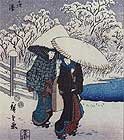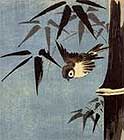

Tales
of Old Japan
by Algernon Bertram Freeman-Mitford
Preface
The Loves of Gompachi and Komurasaki
A
Story of the Otokodate of Yedo
The Wonderful Adventures of Funakoshi Jiuyemon
The Eta Maiden and the Hatamoto
The
Accomplished and Lucky Tea-Kettle
The Story of the Old Man Who Made Withered Trees to Blossom
The Battle of the Ape and the Crab
The Adventures of Little Peachling
The Elves and the Envious Neighbour
How Tajima Shume Was Tormented By a Devil of His Own Creation
Concerning Certain Superstitions
How a Man Was Bewitched and Had His Head Shaved By the Foxes
Preface
In the Introduction to the story of the Forty-seven Rônins, I have said almost as much as is needful by way of preface to my stories.
Those of my readers who are most capable of pointing out the many shortcomings and faults of my work, will also be the most indulgent towards me; for any one who has been in Japan, and studied Japanese, knows the great difficulties by which the learner is beset.
For the illustrations, at least, I feel that I need make no apology. Drawn, in the first instance, by one Ôdaké, an artist in my employ, they were cut on wood by a famous wood-engraver at Yedo, and are therefore genuine specimens of Japanese art. Messrs. Dalziel, on examining the wood blocks, pointed out to me, as an interesting fact, that the lines are cut with the grain of the wood, after the manner of Albert Dürer and some of the old German masters,—a process which has been abandoned by modern European wood-engravers.
It will be noticed that very little allusion is made in these Tales to the Emperor and his Court. Although I searched diligently, I was able to find no story in which they played a conspicuous part.
Another class to which no allusion is made is that of the Gôshi. The Gôshi are a kind of yeomen, or bonnet-lairds, as they would be called over the border, living on their own land, and owning no allegiance to any feudal lord. Their rank is inferior to that of the Samurai, or men of the military class, between whom and the peasantry they hold a middle place. Like the Samurai, they wear two swords, and are in many cases prosperous and wealthy men claiming a descent more ancient than that of many of the feudal Princes. A large number of them are enrolled among the Emperor's body-guard; and these have played a conspicuous part in the recent political changes in Japan, as the most conservative and anti-foreign element in the nation.
With these exceptions, I think that all classes are fairly represented in my stories.
The feudal system has passed away like a dissolving view before the eyes of those who have lived in Japan during the last few years. But when they arrived there it was in full force, and there is not an incident narrated in the following pages, however strange it may appear to Europeans, for the possibility and probability of which those most competent to judge will not vouch. Nor, as many a recent event can prove, have heroism, chivalry, and devotion gone out of the land altogether. We may deplore and inveigh against the Yamato Damashi, or Spirit of Old Japan, which still breathes in the soul of the Samurai, but we cannot withhold our admiration from the self-sacrifices which men will still make for the love of their country.
The first two of the Tales have already appeared in the Fortnightly Review, and two of the Sermons, with a portion of the Appendix on the subject of the Hara-Kiri, in the pages of the Cornhill Magazine. I have to thank the editors of those periodicals for permission to reprint them here.
LONDON, January 7, 1871.
The text came from:
Freeman-Mitford,
A. B. Tales of Old Japan. London: Macmillan, 1871, 1890.
Amazon.com:
Buy the book in paperback.
©Heidi
Anne Heiner, SurLaLune Fairy Tales
E-mail: surlalune@aol.com
Page last updated June 1, 2005
www.surlalunefairytales.com







